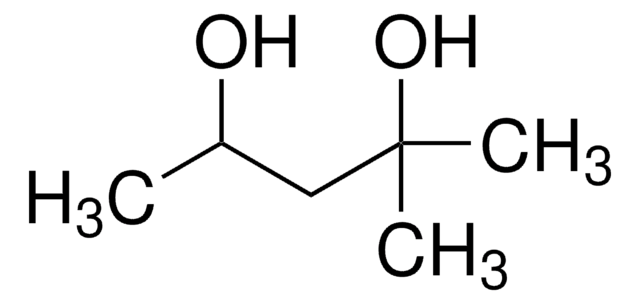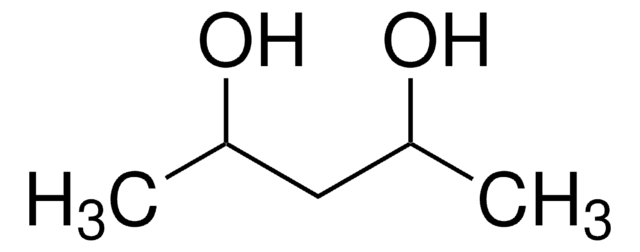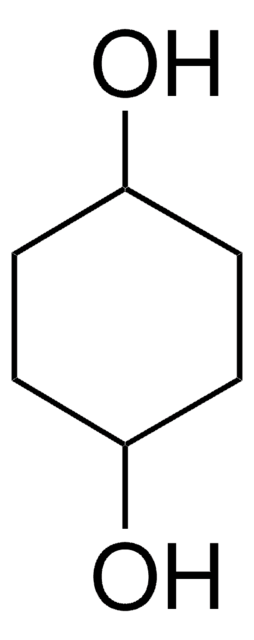H11904
2,5-Hexanediol
99% (mixture of isomers)
Synonym(s):
2,5-Hexylene glycol
Sign Into View Organizational & Contract Pricing
All Photos(1)
About This Item
Linear Formula:
CH3CH(OH)CH2CH2CH(OH)CH3
CAS Number:
Molecular Weight:
118.17
Beilstein:
1719248
EC Number:
MDL number:
UNSPSC Code:
12352100
PubChem Substance ID:
NACRES:
NA.22
Recommended Products
Quality Level
Assay
99% (mixture of isomers)
form
liquid
refractive index
n20/D 1.447 (lit.)
bp
216-218 °C (lit.)
density
0.961 g/mL at 25 °C (lit.)
SMILES string
CC(O)CCC(C)O
InChI
1S/C6H14O2/c1-5(7)3-4-6(2)8/h5-8H,3-4H2,1-2H3
InChI key
OHMBHFSEKCCCBW-UHFFFAOYSA-N
Looking for similar products? Visit Product Comparison Guide
Related Categories
Application
2,5-Hexanediol can be used as:
- A reactant to synthesize N-substituted pyrroles by oxidative coupling with primary amines.
- An alkylating agent to synthesize substituted carbazoles via Friedel-Crafts alkylation with indoles.
- A monomer in the preparation of polyesters by reacting with diacid chlorides.
Signal Word
Warning
Hazard Statements
Precautionary Statements
Hazard Classifications
Acute Tox. 4 Oral - Eye Irrit. 2 - Skin Irrit. 2 - STOT SE 3
Target Organs
Respiratory system
Storage Class Code
10 - Combustible liquids
WGK
WGK 3
Flash Point(F)
213.8 °F - closed cup
Flash Point(C)
101 °C - closed cup
Personal Protective Equipment
dust mask type N95 (US), Eyeshields, Gloves
Choose from one of the most recent versions:
Already Own This Product?
Find documentation for the products that you have recently purchased in the Document Library.
Customers Also Viewed
J Haberland et al.
Applied microbiology and biotechnology, 58(5), 595-599 (2002-04-17)
Diastereoselective reduction of diketones with Lactobacillus kefir DSM 20587 was examined. The reduction of both oxo-functions proceeded highly diastereoselectively. (2 R,5 R)-Hexanediol 3 was produced starting from (2,5)-hexanedione 1 in quantitative yields with enantiomeric excess >99% and diastereomeric excess >99%.
K Kannan et al.
Environmental research, 36(1), 14-25 (1985-02-01)
A preliminary study on immunotoxicologic evaluation of 2,5-hexanediol (one of the principal metabolites of n-hexane), involving multiple immunological parameters, was carried out in mice. Mice were exposed to 2,5-hexanediol at a 1/5 LD50 dose level for 7 days. Pathotoxicological changes
B Bäckström et al.
Archives of toxicology, 67(4), 277-283 (1993-01-01)
Male albino (Sprague Dawley) and pigmented (Norwegian Brown) rats received 1% 2,5-hexanediol (H) in their drinking water for 5 or 8 weeks, respectively. The rats were housed either in 12 h light (average 30 cd/cm2 inside cage) and 12 h
A Bhatt et al.
Journal of applied toxicology : JAT, 8(1), 53-57 (1988-02-01)
The effects of neurotoxic solvents, i.e. 2,5-hexanedione (2,5-HD), 2,5-hexanediol (2,5-HDiol) and the non-neurotoxic solvent, 2,4-hexanedione (2,4-HD) (500 mg/kg body wt./day, i.p.), have been studied on the lipid composition of brain and sciatic nerves in weanling rats. Five-day-old rats were administered
H B Jones et al.
Acta neuropathologica, 58(4), 286-290 (1982-01-01)
Rats were given 2,5-hexanediol, a metabolite of n-hexane, in the drinking water until they developed a marked degree of paresis over about 7 weeks and were then allowed to recover naturally. The time course and the manner of removal of
Our team of scientists has experience in all areas of research including Life Science, Material Science, Chemical Synthesis, Chromatography, Analytical and many others.
Contact Technical Service









